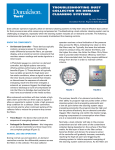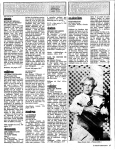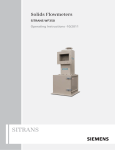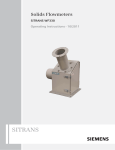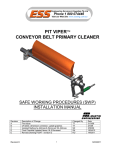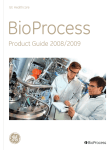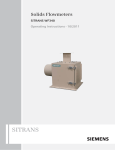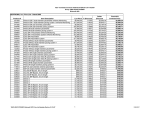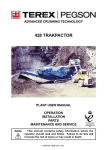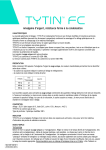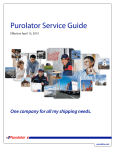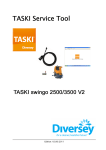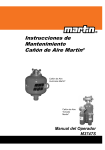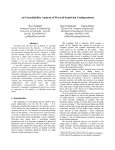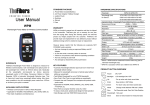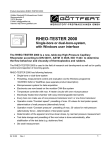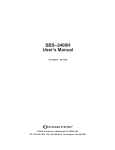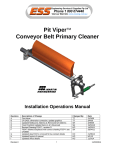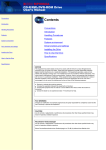Download MARTIN® Insertable Dust Collector
Transcript
MARTIN® Insertable Dust Collector Go to MARTIN® Insertable Dust Collector web page Operator’s Manual M3416 Important MARTIN ENGINEERING HEREBY DISCLAIMS ANY LIABILITY FOR: DAMAGE DUE TO CONTAMINATION OF THE MATERIAL; USER’S FAILURE TO INSPECT, MAINTAIN AND TAKE REASONABLE CARE OF THE EQUIPMENT; INJURIES OR DAMAGE RESULTING FROM USE OR APPLICATION OF THIS PRODUCT CONTRARY TO INSTRUCTIONS AND SPECIFICATIONS CONTAINED HEREIN. MARTIN ENGINEERING’S LIABILITY SHALL BE LIMITED TO REPAIR OR REPLACEMENT OF EQUIPMENT SHOWN TO BE DEFECTIVE. Observe all safety rules given herein along with owner and Government standards and regulations. Know and understand lockout/tagout procedures as defined by American National Standards Institute (ANSI) z244.1-1982, American National Standard for Personnel Protection - Lockout/Tagout of Energy Sources Minimum Safety Requirements and Occupational Safety and Health Administration (OSHA) Federal Register, Part IV, 29 CFR Part 1910, Control of Hazardous Energy Source (Lockout/Tagout); Final Rule. The following symbols may be used in this manual: ! DANGER Danger: Immediate hazards that will result in severe personal injury or death. ! WARNING Warning: Hazards or unsafe practices that could result in personal injury. ! CAUTION Caution: Hazards or unsafe practices that could result in product or property damages. IMPORTANT Important: Instructions that must be followed to ensure proper installation/operation of equipment. NOTE Note: General statements to assist the reader. Section Page List of Figures . . . . . . . . . . . . . . . . . . . . . . . . . . . . . . . . . . . . . . . . . . . . . . . . . . . . . . . . . . . . ii Introduction . . . . . . . . . . . . . . . . . . . . . . . . . . . . . . . . . . . . . . . . . . . . . . . . . . . . . . . . . . . . . . 1 General . . . . . . . . . . . . . . . . . . . . . . . . . . . . . . . . . . . . . . . . . . . . . . . . . . . . . . . . . . . . . . . . . . . . . . Location requirements for transfer point installations . . . . . . . . . . . . . . . . . . . . . . . . . . . . . . . . . . References . . . . . . . . . . . . . . . . . . . . . . . . . . . . . . . . . . . . . . . . . . . . . . . . . . . . . . . . . . . . . . . . . . . Safety . . . . . . . . . . . . . . . . . . . . . . . . . . . . . . . . . . . . . . . . . . . . . . . . . . . . . . . . . . . . . . . . . . . . . . . Materials required . . . . . . . . . . . . . . . . . . . . . . . . . . . . . . . . . . . . . . . . . . . . . . . . . . . . . . . . . . . . . Before Installing Dust Collector . . . . . . . . . . . . . . . . . . . . . . . . . . . . . . . . . . . . . . . . . . . . . . Installing Dust Collector . . . . . . . . . . . . . . . . . . . . . . . . . . . . . . . . . . . . . . . . . . . . . . . . . . . . 1 1 1 2 2 3 4 Electrical connections . . . . . . . . . . . . . . . . . . . . . . . . . . . . . . . . . . . . . . . . . . . . . . . . . . . . . . . . . . 8 Installing timer enclosure. . . . . . . . . . . . . . . . . . . . . . . . . . . . . . . . . . . . . . . . . . . . . . . . . . . . . . . . 9 Initial Operation of Dust Collector . . . . . . . . . . . . . . . . . . . . . . . . . . . . . . . . . . . . . . . . . . . . 11 Maintenance. . . . . . . . . . . . . . . . . . . . . . . . . . . . . . . . . . . . . . . . . . . . . . . . . . . . . . . . . . . . . . 12 Part Numbers . . . . . . . . . . . . . . . . . . . . . . . . . . . . . . . . . . . . . . . . . . . . . . . . . . . . . . . . . . . . . 13 Martin Engineering M3416-10/11 i MARTIN® Insertable Dust Collector Table of Contents Table of Contents List of Figures & Tables List of Figures Figure 1 2 3 4 5 6 7 8 Title Page ® Dimensions for MARTIN Insertable Dust Collector, P/N INS-08XX and INS-10XX . . . . . . . . . . . . . . . . . . . . . . . . . . . . . . . . . . . . . . 4 Dimensions for MARTIN® Insertable Dust Collector, P/N INS-15XX. . . . . . . . 5 Dimensions for MARTIN® Insertable Dust Collector, P/N INS-18XX and INS-20XX . . . . . . . . . . . . . . . . . . . . . . . . . . . . . . . . . . . . . . 6 Dimensions for MARTIN® Insertable Dust Collector, P/N INS-30XX. . . . . . . . 7 Electrical and Plumbing Detail . . . . . . . . . . . . . . . . . . . . . . . . . . . . . . . . . . . . . . . 8 Solenoid Enclosure . . . . . . . . . . . . . . . . . . . . . . . . . . . . . . . . . . . . . . . . . . . . . . . . 9 Solenoid Wiring Schematic . . . . . . . . . . . . . . . . . . . . . . . . . . . . . . . . . . . . . . . . . 9 Timer Enclosure Electrical Connections. . . . . . . . . . . . . . . . . . . . . . . . . . . . . . . . 10 List of Tables Table I II III IV V Title Page Preventative Maintenance Schedule . . . . . . . . . . . . . . . . . . . . . . . . . . . . . . . . . . . 12 MARTIN® Insertable Dust Collector Part Numbers . . . . . . . . . . . . . . . . . . . . . . 13 MARTIN® Insertable Dust Collector Part Numbers . . . . . . . . . . . . . . . . . . . . . . 13 CPV PowerCore® DC Manual Kit Part Numbers . . . . . . . . . . . . . . . . . . . . . . . . 14 MARTIN® Insertable Dust Collector Part Numbers and Weights . . . . . . . . . . . . 14 Martin Engineering M3416-10/11 ii MARTIN® Insertable Dust Collector General The MARTIN® Insertable Dust Collector is an automatic, reverse air dust filter designed to remove dust from the air in conveyor transfer points, silo vents, bucket elevators, and screens. The unit is made up of a group of filter elements mounted on a sealed frame. The elements are fitted side-by-side in an individual sealing arrangement that effectively separates the dirty (inlet) side of the filter from the clean (outlet) side. The elements are always removed for maintenance from the clean side of the filter. This manual provides instructions for locating and installing the MARTIN® Insertable Dust Collector at a conveyor transfer point or silo. For instructions on installing units on bucket elevators or screens, call Martin Engineering or a representative. Information on unit components, assembly, electrical requirements, operation, maintenance, and troubleshooting can be found in the user manual supplied with your unit. Location requirements for transfer point installations To ensure the dust collector’s maximum effectiveness, make sure the transfer point is properly sealed and designed with dust control in mind, as follows: • Chute length: For standard materials or belt speeds up to 250 fpm (1.3 m/s), the transfer point chute length should equal 2 ft per 100 fpm (210 mm per 0.5 m/s) of belt speed. For very dusty materials or belt speeds of 300 fpm (1.5 m/s) and higher, the chute length should equal 3 ft per 100 fpm (914 mm per 0.5 m/s) of belt speed. When in doubt, make the chute longer. • Chute height: For standard materials or belt speeds up to 250 fpm (1.3 m/s), the chute wall should be at least 12 in. (305 mm) high. For very dusty materials or belt speeds of 300 fpm (1.5 m/s) and higher, it should be at least 24 in. (610 mm) high. • Distance from load zone: Locate dust collector as far from actual load zone as possible, and 1/3 of the chute length back from the chute exit point. For best results, install a dust curtain at the exit of the chute. For information on transfer point wear liners and sealing systems, call Martin Engineering or a representative. References The following documents are referenced in this manual: • American National Standards Institute (ANSI) z244.1-1982, American National Standard for Personnel Protection - Lockout/Tagout of Energy Sources - Minimum Safety Requirements, American National Standards Institute, Inc., 1430 Broadway, New York, NY 10018. • Federal Register, Volume 54, Number 169, Part IV, 29 CFR Part 1910, Control of Hazardous Energy Source (Lockout/Tagout); Final Rule, Department of Labor, Occupational Safety and Health Administration (OSHA), 32nd Floor, Room 3244, 230 South Dearborn Street, Chicago, IL 60604. • Donaldson® Torit® Preventative Maintenance Schedule for DF, DFT, DFO, TD, HP, PJ, DLMC, Unicell, Maxcell Dust Collectors, Donaldson Company, Inc., June 2003. Torit® PowerCore® is a registered trademark of Donaldson Company, Inc. Martin Engineering M3416-10/11 1 MARTIN® Insertable Dust Collector Introduction Introduction Introduction Safety All safety rules defined in the above documents and all owner/employer safety rules must be strictly followed when working on this equipment. Materials required In addition to standard hand tools, a hoist is required to install this equipment. Martin Engineering M3416-10/11 2 MARTIN® Insertable Dust Collector IMPORTANT The delivery service is responsible for damage occurring in transit. Martin Engineering CANNOT enter claims for damages. Contact your transportation agent for more information. 1. Inspect shipping container for damage. Report damage to delivery service immediately and fill out delivery service’s claim form. Keep any damaged goods subject to examination. 2. Remove dust collector from shipping container. Equipment in container should include dust collector and controller. 3. If anything is missing, contact Martin Engineering or representative. ! WARNING Before installing equipment, turn off and lock out/tag out energy source to conveyor and conveyor accessories. 4. Turn off and lock out/tag out energy source according to ANSI standards (see “References”). ! WARNING If equipment will be installed in an enclosed area, gas level or dust content must be tested before using a cutting torch or welding. Using a cutting torch or welding in an area with gas or dust may cause an explosion. 5. If using a cutting torch or welding, test atmosphere for gas level or dust content. Cover conveyor belt with fire retardant cover. Martin Engineering M3416-10/11 3 MARTIN® Insertable Dust Collector Before Installation Before Installing Dust Collector Installation Installing Dust Collector 1. Make sure conveyor belt structure and chutework will support dust collector. See Table V for weight specifications. 2. Determine how to best install dust collector on your application. See Figures 1–4 for dimensions. 3. Follow instructions in the included installation manual to install dust collector. Figure 1. Dimensions for MARTIN® Insertable Dust Collector, P/N INS-08XX and INS-10XX Martin Engineering M3416-10/11 4 MARTIN® Insertable Dust Collector Installation Figure 2. Dimensions for MARTIN® Insertable Dust Collector, P/N INS-15XX Martin Engineering M3416-10/11 5 MARTIN® Insertable Dust Collector Installation Figure 3. Dimensions for MARTIN® Insertable Dust Collector, P/N INS-18XX and INS-20XX Martin Engineering M3416-10/11 6 MARTIN® Insertable Dust Collector Installation Figure 4. Dimensions for MARTIN® Insertable Dust Collector, P/N INS-30XX Martin Engineering M3416-10/11 7 MARTIN® Insertable Dust Collector Installation Electrical Power Supply* Timer Enclosure Motor Power Supply Wires* Motor Starter* Timer 120V Power Supply Wires* Control Wires* Filter-Regulator Unit Compressed Air Supply* (80-100 PSI) Air Supply Line* Lockout Valve *Indicates components are supplied by customer Figure 5. Electrical and Plumbing Detail Electrical connections ! WARNING All electrical work must be done to National Electrical Code (NEC) standards. See “References.” ! DANGER For explosion-proof dust collector units, properly ground unit to earth by connecting a ground wire to the earthing boss on the unit. Failure to properly ground the unit can result in a static electricity explosion, damage to equipment, and severe injury or death. 1. For explosion-proof units with INS-XE part numbers, properly connect a ground wire to the unit’s earthing boss (located on the unit next to the symbol shown below) to prevent static electricity buildup. Use the brass screw provided to connect the ground wire to the unit. ! WARNING Before making any connections, lock out/tag out electrical supply to control system according to ANSI standards (see “References”). 2. Connect blower motor to power supply: a. Determine power requirements for motor (see Table III). b. Install a motor starter (not included) per local requirements and codes. c. Interlock motor and timer enclosure and control per plant PLC. Martin Engineering M3416-10/11 8 MARTIN® Insertable Dust Collector Installing timer enclosure CAUTION Do not mount enclosure in area subject to shock, vibration, temperatures exceeding 130°F (55°C), or explosion. Damage to control system circuitry could result. 1. Determine location for timer enclosure. 2. Mount onto wall with fasteners. 3. Drill conduit holes in enclosure for solenoid and power wires. Use care not to damage internal components. Drill in most weather-proof location available on enclosure. B A C A. Screws B. Solenoid Enclosure Cover D C D C. Solenoid Terminal (Line) D. Solenoid Terminal (Neutral) Figure 6. Solenoid Enclosure 4. Loosen screws (A) and remove solenoid enclosure cover (B). Solenoid Enclosure SOL 1 Factory Wired Wired at Installation SOL 2 SOL 3 SOL 4 SOL 5 SOL 6 COM L1 L2 COM 1 2 3 4 5 6 Timer Enclosure Terminal Block Figure 7. Solenoid Wiring Schematic Martin Engineering M3416-10/11 9 MARTIN® Insertable Dust Collector Installation ! Installation 5. Using electrical connectors, route required wires from solenoid valves to timer enclosure. Connect wires to solenoid terminals. 6. Reinstall solenoid enclosure cover (B, Figure 6). L1 Solenoids L2 Com Figure 8. Timer Enclosure Electrical Connections 7. Route power wire (120VAC 60Hz) into timer enclosure. 8. Connect ground wire to ground terminal. Connect neutral wire to terminal labeled L2. Connect phase wire to terminal labeled L1. 9. Reinstall timer enclosure cover. Martin Engineering M3416-10/11 10 MARTIN® Insertable Dust Collector IMPORTANT Read entire section before beginning work. ! WARNING Dust collector may produce loud noise when mounted on structure. See OSHA 1910.95 for guidelines. If required, wear ear protection to avoid impairment or loss of hearing. 1. If dust collector produces loud noise according to OSHA 1910.95, wear ear protection. ! WARNING Failure to remove tools from installation area and conveyor belt before turning on energy source can cause serious injury to personnel and damage to belt. 2. Remove all tools and fire retardant cover from installation area and conveyor belt. ! DANGER Do not touch or go near conveyor belt or conveyor accessories when conveyor belt is running. Body or clothing can get caught and pull body into conveyor belt, causing severe injury or death. 3. Turn power ON at the source. 4. Start blower fan for one second, then stop. 5. Check motor and fan for the correct rotation by referencing the rotation sticker located on the motor mounting plate. Check for smooth operations of fan wheel and motor. If motor is not rotating in correct direction, lock out/tag out energy source and reverse rotation. 6. Ensure damper is set in completely closed position. 7. Turn compressed air on at the source. Adjust the regulator until pressure is between 90 and 100 PSI (6.2–6.8 Bar). 8. Turn conveyor belt ON and ensure material is flowing. 9. Turn the blower fan ON. 10. Open the damper 50% while the dust collector is under dust load. 11. Operate dust collector for 5 to 10 minutes. 12. Open the damper until the transfer point is under a negative air flow. 13. Operate and maintain dust collector according to user manual supplied with your unit. Martin Engineering M3416-10/11 11 MARTIN® Insertable Dust Collector Operation Initial Operation of Dust Collector Maintenance Maintenance Table I. Preventative Maintenance Schedule Item Monitor Exhaust of Fan to ensure filter integrity. Collector Filter Pressure Drop Filter Pressure Drop Pneumatic Lines Compressed Air Supply Frequency Procedure Daily Monitor exhaust from fan. The exhaust should remain visibly clean. If a leak of dust develops, it will be noticed as a visual puff from the fan exhaust immediately after a cleaning pulse. If dust is visible consult your Installation and Operation Manual for troubleshooting recommendations. Weekly Visually inspect and record the operating pressure drop across each dust collector. It is normal for the pressure drop to fluctuate during operation as the collector passes through cleaning cycles, and as production schedules fluctuate from light to heavy. New filters may have a pressure drop of less than 1” w.g., however, as filters become seasoned, they will reach an equilibrium pressure drop. Generally 1 to 6” w.g. is considered normal. An excessively high pressure drop could be an indication of a malfunction in the cleaning mechanism, excessive airflow, plugged filters, or heavy dust loading conditions. Consult your Installation and Operation Manual for troubleshooting recommendations. Monthly To ensure correct pressure drop indication, remove one line at a time from the pressure drop indicating gauge barb fitting. Using a minimum 20 psi compressed air, blow through the line back towards the dust collector. (Do not use more than 25 psi to blow through clear poly tubing as damage may occur.) Monthly Air dryers and automatic condense valve should be used prior to each dust collector. Inspect monthly to ensure proper operation, and that moisture is being removed from the compressed air supply. Troubleshoot, repair, or replace per the specific manufactures’ instructions. Consult your Installation and Operation Manual for correct pulse pressure recommendations for the dust collector. Pulse Diaphragms Apply electrical and pneumatic service to the pulse cleaning control. Activate the pulse cleaning sequence by placing the control in continuous cleaning mode. Approximately Every 3 Months every ten (10) seconds an audible pulse should be heard. This process should be performed simultaneously with the solenoid check described below. Electrical Solenoids Apply electrical and pneumatic service to the pulse cleaning control. Activate the pulse cleaning sequence by placing the control in continuous cleaning mode. Approximately every ten (10) seconds an audible pulse should be heard. Additionally, each solenoid Every 3 Months should be inspected manually by placing a large flat, light-weight surface (cloth) behind each solenoid enclosure. As each solenoid is activated, in that particular enclosure, visually inspect the test surface for movement. (When the solenoid is energized, compressed air is released from the diaphragm valves through the solenoid.) Verify conditions of Filters If filter element pressure drop exceeds 6” w.g. verify proper system airflow according to original design recommendations. Remember that excessive airflow can increase Every 6 Months pressures drop. Change filters if necessary. Always use Donaldson superior filters for best performance and life. Verify operations of Pulse Cleaning System Inspect Diaphragms, Solenoids and Timer to ensure proper filter cleaning. Consult the Every 6 Months Installation and Operation Manual for your dust collector for the correct On and Off time settings for Pulse cleaning intervals and duration. Check fan and motor Check motor and fan for the correct rotation by referencing the rotation sticker located on the motor mounting plate. Check for smooth operations of fan wheel and motor. Every 6 Months Inspect for and tighten belts, nuts, bolts and set screws as needed. Consult the Installation and Operation Manual for troubleshooting recommendations as needed. Adjust exhaust Damper Every 6 Months as needed Install filters correctly Adjust exhaust Damper Airflow should be adjusted to match design recommendations. Excessive airflow can shorten filter life and cause fan motor failure. During filter changes Consult the Installation and Operation Manual for recommendations to correctly install new filters. Install new filters correctly and adequately tightened to prevent dust leakage. Improperly installed or inadequately tightened filters can allow dust to pass through the dust collector. Immediately after filter changes Because the pressure drop or restriction to airflow through the filters will decrease when new filters are installed, airflow through the collector will increase. Because of this it is necessary to adjust the fan damper to restrict the airflow through the collector to the recommended level immediately after installation of new filters. As the filters age and the pressure drop or restrictions to air increases, you may need to open the damper to reach design conditions. Martin Engineering M3416-10/11 12 MARTIN® Insertable Dust Collector See the following tables for MARTIN® Insertable Dust Collector unit assembly part numbers. For replacement filter elements, manifold valves, and solenoid valves, call Martin Engineering at 800-544-2947. Table II. MARTIN® Insertable Dust Collector Part Numbers Item Description PowerCore® 1 CPV 2 TRB Fan Pack PowerCore® Dust Collector Part Number Quantity Table III 1 Table III 1 38435-K (See Table IV) 1 3 CPV 4 Adapter Flange Weldment Table III 1 5 Hardware Kit Table III 1 DC Manual Kit Table III. MARTIN® Insertable Dust Collector Part Numbers Part No. Airflow CFM Voltage P/N Item 1 P/N Item 2 P/N Item 4 P/N Item 5 INS-084 0-800 460V 60Hz 38432-2 38433-2 38627-CPV-2 38627-2H INS-084E 0-800 460V 60Hz 38432-2E 38433-2E 38627-CPV-2 38627-2H INS-084EH 0-800 460V 60Hz 38432-2EH 38433-2E 38627-CPV-2 38627-2H INS-103 0-1000 380V 50Hz 38432-2 38434-3-38050 38627-CPV-2 38627-2H INS-104 800-1000 460V 60Hz 38432-2 38433-3 38627-CPV-2 38627-2H INS-104E 800-1000 460V 60Hz 38432-2E 38433-3E 38627-CPV-2 38627-2H INS-104EH 800-1000 460V 60Hz 38432-2EH 38433-3E 38627-CPV-2 38627-2H INS-153 1000-1500 380V 50Hz 38432-3 38434-3-38050 38627-CPV-3 38627-3H INS-154 1000-1500 460V 60Hz 38432-3 38433-3 38627-CPV-3 38627-3H INS-154E 1000-1500 460V 60Hz 38432-3E 38433-3E 38627-CPV-3 38627-3H INS-154EH 1000-1500 460V 60Hz 38432-3EH 38433-3E 38627-CPV-3 38627-3H INS-184 1500-1800 460V 60Hz 38432-4 38434-3 38627-CPV-4 38627-4H INS-184E 1500-1800 460V 60Hz 38432-4E 38434-3E 38627-CPV-4 38627-4H INS-184EH 1500-1800 460V 60Hz 38432-4EH 38434-3E 38627-CPV-4 38627-4H INS-203 1500-2000 380V 50Hz 38432-4 38434-5-38050 38627-CPV-4 38627-4H INS-204 1800-2000 460V 60Hz 38432-4 38433-5 38627-CPV-4 38627-4H INS-204E 1800-2000 460V 60Hz 38432-4E 38433-5E 38627-CPV-4 38627-4H INS-204EH 1800-2000 460V 60Hz 38432-4EH 38433-5E 38627-CPV-4 38627-4H INS-303 2000-3000 380V 50Hz 38432-6 38434-7.5-38050 38627-CPV-6 38627-6H INS-304 2000-3000 460V 60Hz 38432-6 38434-5 38627-CPV-6 38627-6H INS-304E 2000-3000 460V 60Hz 38432-6E 38434-5E 38627-CPV-6 38627-6H INS-304EH 2000-3000 460V 60Hz 38432-6EH 38434-5E 38627-CPV-6 38627-6H Martin Engineering M3416-10/11 13 MARTIN® Insertable Dust Collector Part Numbers Part Numbers Part Numbers Table IV. CPV Powercore® DC Manual Kit Part Numbers Item Description Part Number Quantity 1 Nipple Hex 1-NPT 36009 5 2 Union 1-NPT Galvanized 36274 2 3 Valve Ball Safety Shutoff 1 NPT 32284-04 2 4 Gauge Air GLYSRL Fill 1/4-NPT 160 PSI 34842 1 5 Filter/Regulator 1-NPT 38736 1 6 Operator’s Manual M3416 1 Table V. MARTIN® Insertable Dust Collector Part Numbers and Weights MARTIN® Insertable Dust Collector* Part No. DCE Model No. Weight lb (kg) Adapter Flange P/N 38432-2 CPV-2 320 (145) 38627-CPV-2 38432-3 CPV-3 400 (181) 38627-CPV-3 38432-4 CPV-4 500 (227) 38627-CPV-4 38432-6 CPV-6 655 (297) 38627-CPV-6 Dust Collector Motor* Part No. Power hp Weight lb (kg) 38433-2 2 63 (29) 38433-3 3 87 (39) 38433-5 5 124 (56) 38434-3 3 155 (70) 38434-5 5 178 (81) * For explosive environments, add an E to end of dust collector and motor part numbers. Martin Engineering M3416-10/11 14 MARTIN® Insertable Dust Collector Any product, process, or technology described here may be the subject of intellectual property rights reserved by Martin Engineering Company. Trademarks or service marks designated with the ® symbol are registered with the U.S. Patent and Trademark Office and may be proprietary in one or more countries or regions. Other trademarks and service marks belonging to Martin Engineering Company in the United States and/or other countries or regions may be designated with the “TM” and “SM” symbols. Brands, trademarks, and names of other parties, who may or may not be affiliated with, connected to, or endorsed by Martin Engineering Company, are identified wherever possible. Additional information regarding Martin Engineering Company’s intellectual property can be obtained at www.martin-eng.com/trademarks. Martin Engineering USA One Martin Place Neponset, IL 61345-9766 USA 800 544 2947 or 309 852 2384 Fax 800 814 1553 www.martin-eng.com Form No. M3416-10/11 Subject to change without prior notice. Quality Management System Certified by DNV - ISO 9001 © Martin Engineering Company 1998, 2011




















